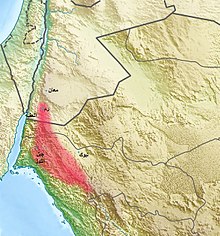| Hismaic | |
|---|---|
| Region | Hisma (ar) |
| Old North Arabian script | |
| Language codes | |
| ISO 639-3 | – |
| Glottolog | hism1236 |
Hismaic (Arabic: حسمائية) is a variety of the Ancient North Arabian script and the language most commonly expressed in it. The Hismaic script may have been used to write Safaitic dialects of Old Arabic, but the language of most inscriptions differs from Safaitic in a few important respects, meriting its classification as a separate dialect or language.[citation needed] Hismaic inscriptions are attested in the Ḥismā region of Northwest Arabia, dating to the centuries around and immediately following the start of the Common Era.
Geographic area[edit]

Characteristics[edit]
Phonology[edit]
Hismaic has undergone the merger of Proto-Semitic s¹ + s³, the same as all Arabic varieties and Dadanitic. There are clear instances of d being used for /ḏ/ in the variant spellings of the divine name Ḏū l-S2arā as ds2r or ds2ry – as against classical ḏs2r or ḏs2ry, although these are probably Aramaicisms, under Nabataean influence.
The spelling ʿbdmk for ʿbdmlk suggests an interchange of n for l (with unvocalised n assimilated to the following k), similar to that found in Nabataean where the name of the kings named Malichos occurs as both mlkw and mnkw and the compound as both ʿbdmlkw and ʿbdmnkw.[1]
Grammar[edit]
Perhaps the most salient distinction between Safaitic and Hismaic is the attestation of the definite articles h-, hn-, ʾ-, and ʾl- in the former. A prefixed definite article is not attested in Hismaic. Nevertheless, Hismaic seems to attest a suffixed -ʾ on nouns and hn in personal names. The use of the morpheme h- as a demonstrative is attested.[2]
References[edit]
- ^ "Archived copy" (PDF). Archived from the original (PDF) on 2019-12-16. Retrieved 2015-12-08.
{{cite web}}: CS1 maint: archived copy as title (link) - ^ Al-Jallad, A. (2015). An Outline of the Grammar of the Safaitic Inscriptions. Brill.
Well, that’s interesting to know that Psilotum nudum are known as whisk ferns. Psilotum nudum is the commoner species of the two. While the P. flaccidum is a rare species and is found in the tropical islands. Both the species are usually epiphytic in habit and grow upon tree ferns. These species may also be terrestrial and grow in humus or in the crevices of the rocks.
View the detailed Guide of Psilotum nudum: Detailed Study Of Psilotum Nudum (Whisk Fern), Classification, Anatomy, Reproduction